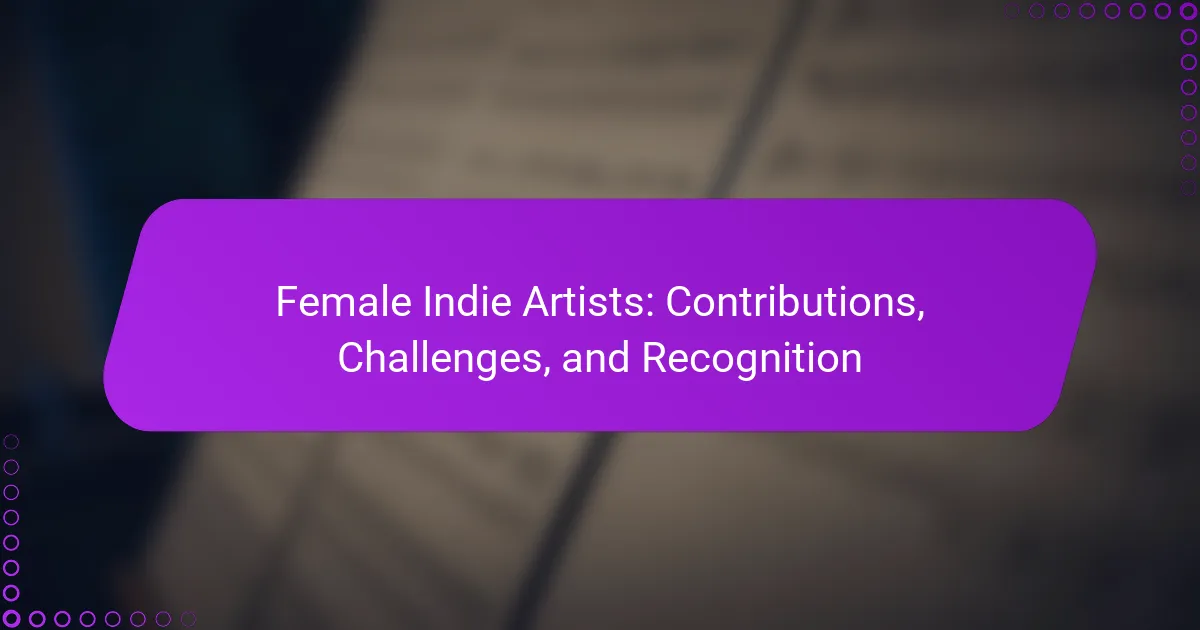Female indie artists play a crucial role in enriching the music industry with their innovative sounds and diverse storytelling. They face significant challenges such as gender bias, limited funding, and lack of visibility. Despite these hurdles, their contributions are increasingly recognized through awards and grassroots support. Regional differences also shape their experiences, influencing opportunities and community recognition.
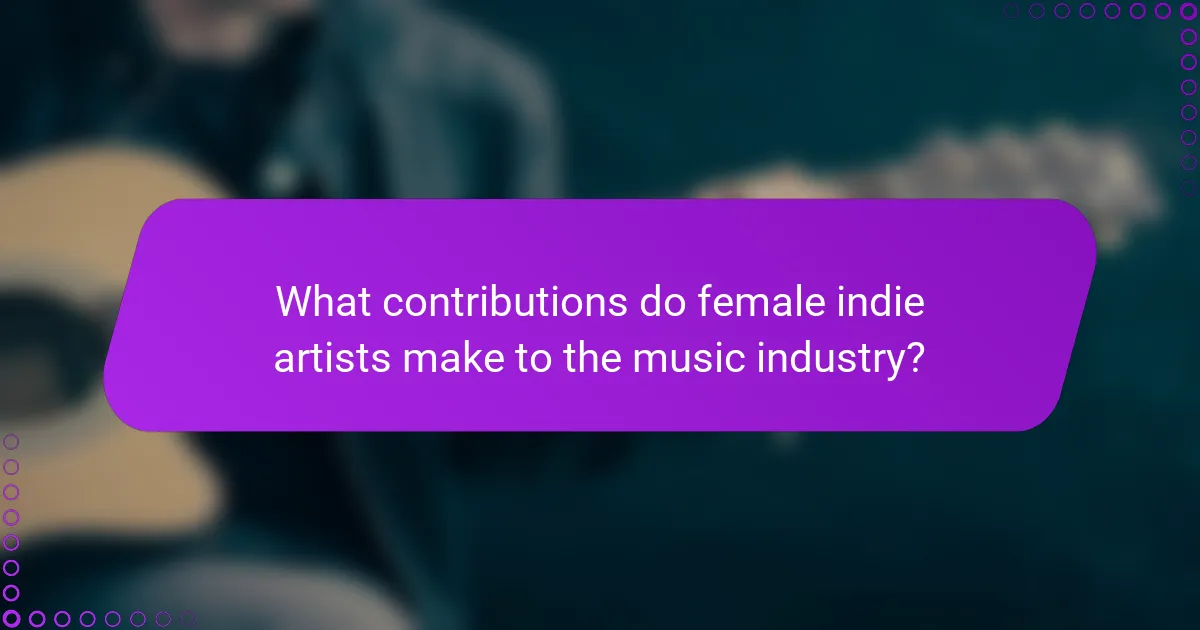
What contributions do female indie artists make to the music industry?
Female indie artists significantly enrich the music industry through innovation, diversity, and unique storytelling. They challenge mainstream norms, offering fresh perspectives and authentic voices. Their contributions include expanding genre boundaries and creating inclusive spaces for underrepresented artists. For example, female indie musicians often address social issues, fostering community and dialogue through their lyrics. Recognition for their work has grown, with many receiving awards and critical acclaim, highlighting their impact on the industry.
How do female indie artists influence musical genres and trends?
Female indie artists significantly influence musical genres and trends by introducing diverse sounds and perspectives. Their contributions often challenge traditional norms, leading to innovative musical expressions.
For instance, artists like Phoebe Bridgers and Mitski have reshaped indie rock through introspective lyrics and genre-blending styles. Their unique attributes, such as Bridgers’ haunting melodies and Mitski’s emotional depth, resonate with audiences, inspiring emerging artists.
Moreover, female indie artists face challenges like industry bias and underrepresentation. Despite these obstacles, their recognition continues to grow, with increased visibility in festivals and charts. This shift highlights the evolving landscape of music where female voices are essential in driving trends.
As a result, the impact of female indie artists extends beyond music; it fosters a cultural movement that embraces authenticity and diversity in the industry.
What role do female indie artists play in cultural representation?
Female indie artists play a vital role in cultural representation by amplifying diverse voices and perspectives. They challenge mainstream narratives through unique storytelling and innovative sound. Their contributions enrich the music landscape, fostering inclusivity and authenticity. Recognition of their work has grown, yet they still face challenges in gaining equal opportunities and visibility. This ongoing struggle highlights the importance of supporting female artists to ensure a more balanced cultural representation.
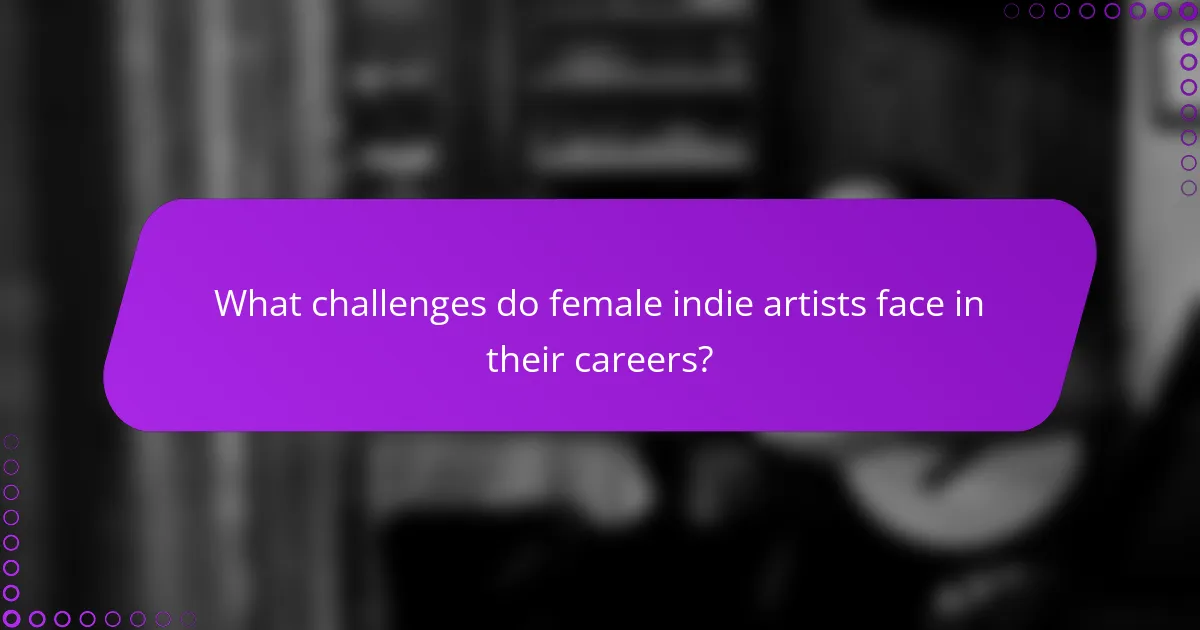
What challenges do female indie artists face in their careers?
Female indie artists face numerous challenges, including gender bias, limited funding, and lack of visibility. These hurdles hinder their career growth and recognition in a male-dominated industry.
Gender bias remains a significant challenge, impacting opportunities for collaboration and performance. Studies show that female artists receive less media coverage compared to their male counterparts, affecting their visibility.
Limited funding poses another barrier. Female indie artists often struggle to secure financial support for projects, leading to fewer resources for marketing and production.
Moreover, networking opportunities are often skewed, with male-dominated spaces making it difficult for female artists to connect with industry professionals. This lack of access can stifle their growth and limit career advancement.
How does gender bias affect female indie artists?
Gender bias significantly hinders female indie artists by limiting their opportunities and visibility in the music industry. Female artists often face challenges such as unequal representation in festivals and media coverage. Statistics reveal that only 22% of artists played at major music festivals are women, highlighting systemic barriers. This bias affects their recognition and success, creating an environment where their contributions may be overlooked. As a result, female indie artists frequently struggle to gain the same level of support and resources as their male counterparts, impacting their overall career progression.
What are the financial hurdles for female indie artists?
Female indie artists face significant financial hurdles that hinder their growth and visibility. Limited access to funding, lower revenue from music sales, and high marketing costs contribute to these challenges. Additionally, gender bias in the industry often leads to fewer opportunities for financial support and investment. As a result, many female artists struggle to sustain their careers despite their contributions to the music scene.
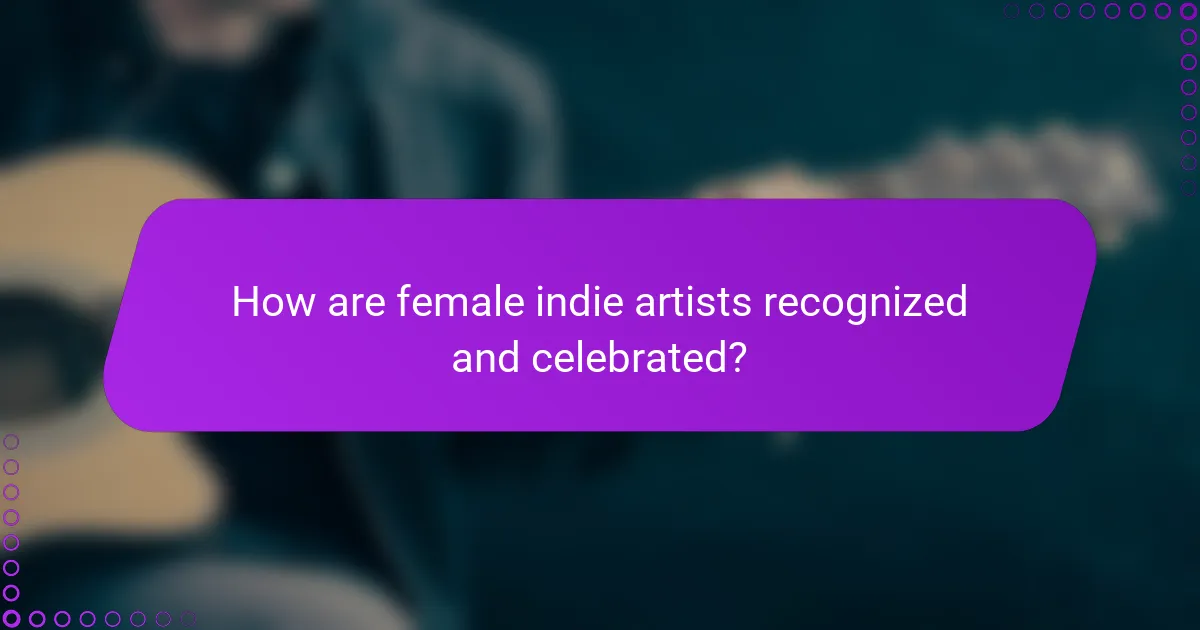
How are female indie artists recognized and celebrated?
Female indie artists are recognized and celebrated through various platforms, awards, and community support. Their contributions to music often highlight unique perspectives and diverse genres. Recognition comes from both industry accolades and grassroots movements. Festivals, social media, and collaborations help elevate their visibility, fostering a sense of community and appreciation for their artistry.
Which awards and festivals highlight female indie talent?
Several awards and festivals prominently recognize female indie talent, including the Women’s Music Festival, the International Women’s Day Music Festival, and the She Rocks Awards. These events celebrate contributions by female artists while addressing industry challenges. The Women’s Music Festival focuses on showcasing emerging talent, while the She Rocks Awards honors women who have made significant impacts in music. Each event fosters a supportive environment for female artists, promoting their visibility and success.
How do social media platforms impact the visibility of female indie artists?
Social media platforms significantly enhance the visibility of female indie artists. These platforms provide direct access to audiences, allowing artists to showcase their work without traditional barriers.
Engagement metrics indicate that female indie artists often experience higher interaction rates on platforms like Instagram and TikTok. For instance, a study found that 65% of female artists reported increased fan engagement through social media.
Moreover, social media fosters community building, enabling female indie artists to connect with peers and supporters. This network often leads to collaborative opportunities, further amplifying their reach.
Finally, algorithms on these platforms can favor unique content, which many female indie artists excel in creating. This aspect can lead to viral moments, significantly boosting their recognition in a competitive industry.
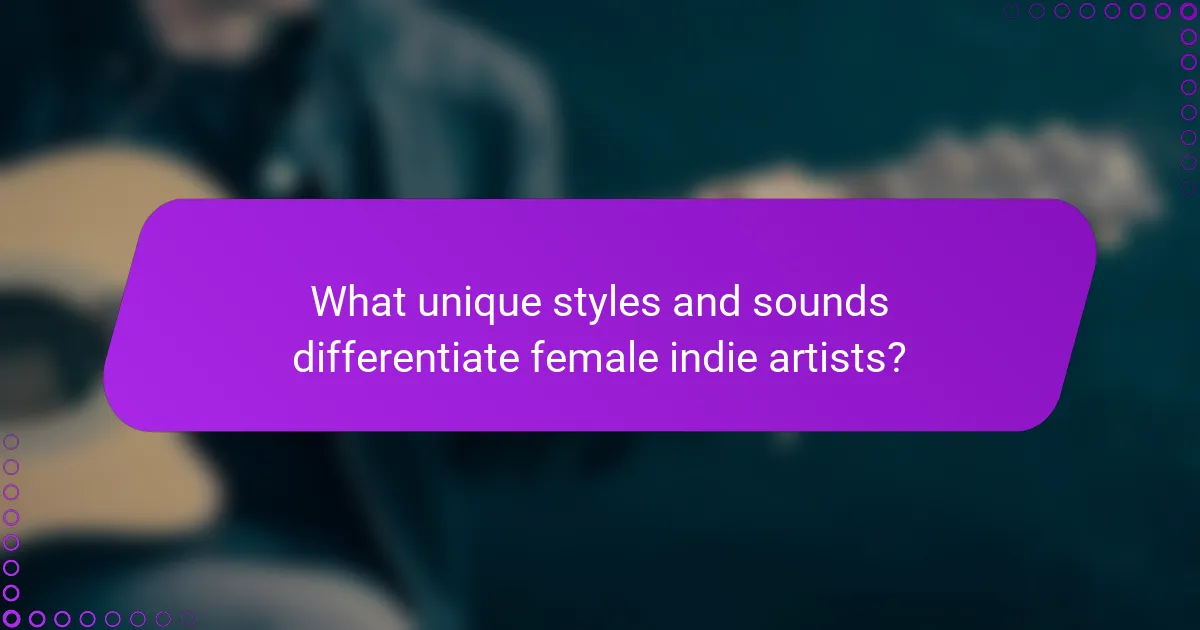
What unique styles and sounds differentiate female indie artists?
Female indie artists distinguish themselves through diverse styles and unique sounds, often blending genres. Their contributions reflect personal narratives and cultural experiences, creating a distinct authenticity. Unique attributes include experimental instrumentation and lyrical introspection, setting them apart from mainstream music. As a result, they challenge industry norms and receive growing recognition for their innovative approaches.
How do personal experiences shape the music of female indie artists?
Personal experiences profoundly shape the music of female indie artists by influencing their lyrical themes and emotional expression. These artists often draw from personal narratives, societal challenges, and cultural backgrounds, creating authentic and relatable music. For instance, many female indie musicians address issues like gender inequality and mental health, reflecting their unique journeys. This connection to personal experience enhances their storytelling and fosters a deeper audience engagement, making their contributions significant in the music industry.
What innovative collaborations are seen among female indie artists?
Female indie artists frequently collaborate to innovate and amplify their voices. These partnerships often blend diverse musical styles and perspectives, resulting in unique artistic expressions. For instance, projects like “Sister Duo” feature female artists combining genres, enhancing visibility and recognition. Collaborations also address challenges such as funding and marketing, creating supportive networks that empower participants. Notable examples include joint performances at festivals and co-writing sessions, which foster community and creativity among female musicians.
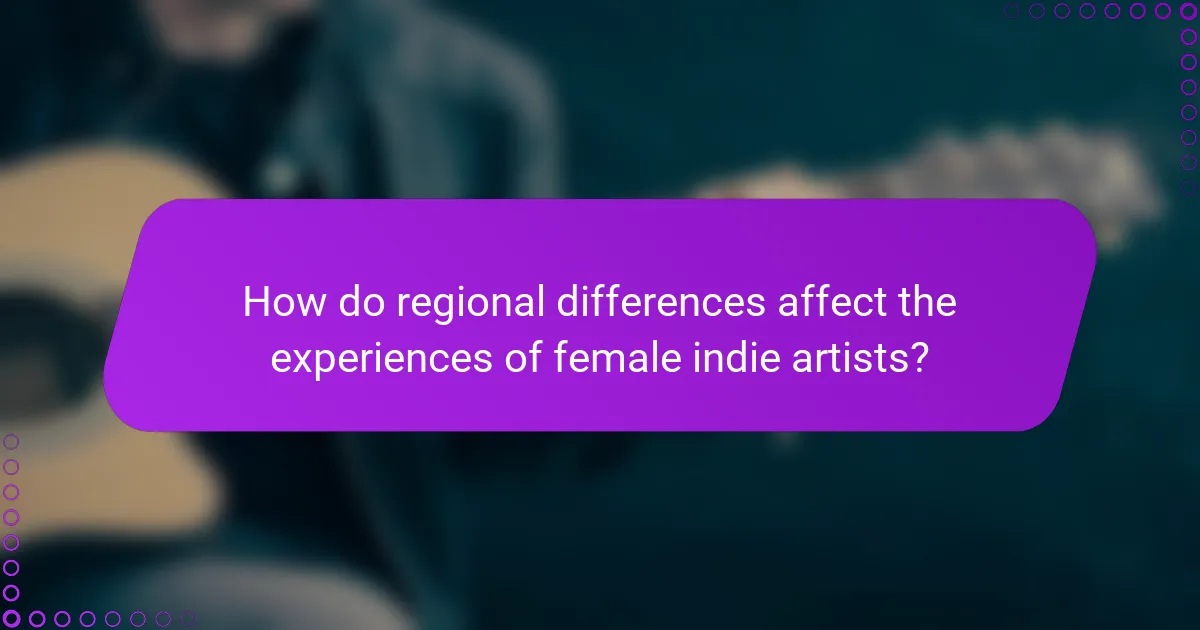
How do regional differences affect the experiences of female indie artists?
Regional differences significantly impact the experiences of female indie artists by shaping their opportunities, challenges, and recognition. Cultural norms and industry structures vary widely, influencing access to resources and platforms. For instance, artists in urban areas often have greater access to venues and networking opportunities compared to those in rural settings. Additionally, regional music scenes can prioritize different genres, affecting the visibility of female artists. Recognition can also differ, with some regions celebrating local talent more than others, impacting an artist’s career trajectory and community support.
Which cultural factors influence the indie music scene for female artists?
Cultural factors significantly influence the indie music scene for female artists. These include societal norms, representation, and access to resources.
Societal expectations often shape the themes and styles female artists explore. For instance, traditional gender roles can restrict creative expression.
Representation in media impacts visibility and acceptance. Increased female representation in festivals and playlists enhances recognition and inspires upcoming artists.
Access to resources, such as funding and mentorship, varies across cultures. In some regions, female artists face greater challenges in obtaining support compared to their male counterparts.
How do female indie artists navigate the global music landscape?
Female indie artists navigate the global music landscape through creativity, resilience, and strategic networking. They often face challenges such as limited funding and industry bias. However, their unique contributions enrich the music scene, leading to increased recognition and opportunities. Collaboration with other artists and leveraging social media platforms enhance their visibility and reach. As a result, many female indie artists successfully carve out distinct identities and communities within the global music framework.
What are the emerging trends for female indie artists in 2025?
Female indie artists will increasingly leverage digital platforms for distribution, collaboration, and audience engagement in 2025. The rise of social media tools will enhance visibility and foster community support. Additionally, a focus on sustainability and authenticity will shape their branding and music production. Data indicates that female artists will gain more recognition through festivals and industry initiatives promoting diversity. Moreover, emerging technologies like AI will influence music creation and marketing strategies, allowing for innovative soundscapes and personalized listener experiences.
What best practices can female indie artists adopt for success?
Female indie artists can adopt several best practices for success. Building a strong online presence is crucial, as it allows artists to connect with fans and showcase their music. Collaborating with other musicians can enhance creativity and expand reach. Engaging in social media marketing effectively promotes their work and builds a loyal fan base.
Networking within the music industry opens doors for opportunities, while attending workshops can improve skills and knowledge. Understanding the business side of music, including rights and royalties, empowers artists to make informed decisions. Lastly, staying authentic to their artistic vision resonates with audiences and fosters long-term success.
